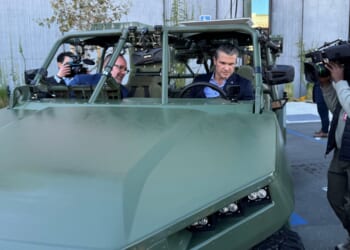In September, Anduril conducted successful test flights of Roadrunner prototypes, including deployments from a prototype launch enclosure.
The race is on to dominate the explosive and growing military drone market. So ubiquitous have drones become on the modern battlefield, as demonstrated by the Ukraine War, that there are now rapidly advancing counter-unmanned aerial systems (cUAS) being designed to better defend against unpredictable drone attacks of the kind that have defined the front lines of the Ukraine War.
Anduril Industries, a defense technology company focused on autonomous systems and artificial intelligence (AI) integration, has developed the Roadrunner family of vehicles as part of its cUAS portfolio.
The Power of Drones—and Counter-Drones
Anduril’s Roadrunner is a modular, twin-jet-powered autonomous air vehicle (AAV) designed for vertical takeoff and landing (VTOL), while the Roadrunner-M is its high-explosive interceptor variant specifically built for ground-based air defense against aerial threats like drones, cruise missiles, and even manned aircraft. These prototypes represent a new class of reusable, operator-supervised AAVs that can be rapidly deployed from a containerized “Nest” enclosure.
Recent developments include Anduril’s selection last year by the Defense Innovation Unit (DIU) for the Counter NEXT program, aimed at creating cost-effective drone-killing capabilities for the United States Navy.
In September, Anduril conducted successful test flights of Roadrunner prototypes, including deployments from a prototype launch enclosure, leading to additional Pentagon funding to refine the systems, integrate them with existing combat platforms, and prepare for live-fire tests next summer.
Roadrunner has been operationally deployed for combat evaluation since last January. Pairs of vehicles autonomously returned after intercepting non-threatening targets during demonstrations at that time, highlighting their recoverability for reuse.
These prototypes are situated to become increasingly important in future conflicts, due to the rapid proliferation of low-cost, one-way attack drones and unmanned aerial systems (UAS), as seen in operations against the Houthi Rebels in Yemen and in the Red Sea.
Traditional defenses often rely on expensive missiles (costing millions) to counter cheap threats (costing thousands), creating a cost asymmetry that depletes resources quickly. Roadrunner addresses this by providing a scalable, mass-producible interceptor that offers a “deeper magazine” of affordable munitions, preserving high-end weapons for threats while enabling rapid reloading and integration with existing programs, like Anduril’s Lattice AI program.
Its reusability reduces long-term costs—if no target is engaged, the vehicle can land vertically and be redeployed, supporting sustained operations in high-threat environments. For naval applications, it enhances ship protection within a 15-kilomater radius with over 90 percent probability of kill for direct defense and over 70 percent for area coverage of shipping lanes, adapting to evolving threats via upgradable software for faster decision-making in human-in/on-the-loop modes.
As drone swarms and autonomous threats grow in sophistication—driven by advancements in AI and manufacturing—these systems will be critical for maintaining air superiority, protecting critical infrastructure, and enabling allied forces to counter asymmetric warfare effectively without economic strain.
Why Doesn’t the US Army Trust Anduril?
Of course, it’s not all a bed of roses for Anduril. A recent Reuters report reveals a leaked United States Army report dated September 2025 that describes the joint Anduril-Palantir Next Generation Command and Control (NGC2) platform, a battlefield communication system, as being “very high risk” due to alleged deep flaws in data security, user activity monitoring, and software verification.
The Army’s assessment highlighted that the platform lacks robust controls to limit data access, monitor user actions, or ensure the software’s integrity. It also flagged risks of unauthorized data exfiltration and insufficient encryption. Both Anduril and Palantir strongly rejected the memo’s claims. Nevertheless, many online commentators, including some prominent military analysts, have consistently challenged Anduril’s claims at being dominant in the software development side of the drone business.
Regardless of these accusations lobbed against Anduril, it is currently a leader in the US military’s rapid development of drone—and counter-drone—systems. And the recent news of its successful testing of cUAS interceptors just shows that Anduril will continue to play a significant role in the defense of the United States on the modern battlefield.
About the Author: Brandon J. Weichert
Brandon J. Weichert is a senior national security editor at The National Interest. Recently, Weichert became the host of The National Security Hour on America Outloud News and iHeartRadio, where he discusses national security policy every Wednesday at 8pm Eastern. He is also a contributor at Popular Mechanics and has consulted regularly with various government institutions and private organizations on geopolitical issues. Weichert’s writings have appeared in multiple publications, including The Washington Times, National Review, The American Spectator, MSN, The Asia Times, and others. His books include Winning Space: How America Remains a Superpower, Biohacked: China’s Race to Control Life, and The Shadow War: Iran’s Quest for Supremacy. His newest book, A Disaster of Our Own Making: How the West Lost Ukraine is available for purchase wherever books are sold. He can be followed via Twitter @WeTheBrandon.
Image: Shutterstock / Alones.


















